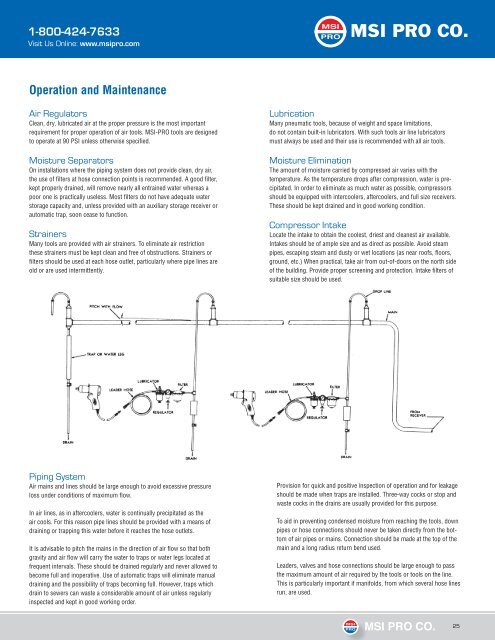MSI-PRO CO. - Jewett-Cameron Trading Company
MSI-PRO CO. - Jewett-Cameron Trading Company
MSI-PRO CO. - Jewett-Cameron Trading Company
Create successful ePaper yourself
Turn your PDF publications into a flip-book with our unique Google optimized e-Paper software.
Operation and Maintenance<br />
<br />
Clean, dry, lubricated air at the proper pressure is the most impor tant<br />
requirement for proper operation of air tools. <strong>MSI</strong>-<strong>PRO</strong> tools are designed<br />
to operate at 90 PSI unless other wise specified.<br />
<br />
On installations where the piping system does not provide clean, dry air,<br />
the use of filters at hose connection points is recommend ed. A good filter,<br />
kept properly drained, will remove nearly all entrained water whereas a<br />
poor one is practically useless. Most fil ters do not have adequate water<br />
storage capacity and, unless pro vided with an auxiliary storage receiver or<br />
automatic trap, soon cease to function.<br />
<br />
Many tools are provided with air strainers. To eliminate air restric tion<br />
these strainers must be kept clean and free of obstructions. Strainers or<br />
filters should be used at each hose outlet, particularly where pipe lines are<br />
old or are used intermittently.<br />
<br />
Air mains and lines should be large enough to avoid excessive pressure<br />
loss under conditions of maximum flow.<br />
In air lines, as in aftercoolers, water is continually precipitated as the<br />
air cools. For this reason pipe lines should be provided with a means of<br />
draining or trapping this water before it reaches the hose outlets.<br />
It is advisable to pitch the mains in the direction of air flow so that both<br />
gravity and air flow will carry the water to traps or water legs located at<br />
frequent intervals. These should be drained regular ly and never allowed to<br />
become full and inoperative. Use of auto matic traps will eliminate manual<br />
draining and the possibility of traps becoming full. However, traps which<br />
drain to sewers can waste a considerable amount of air unless regularly<br />
inspected and kept in good working order.<br />
<br />
<br />
<strong>MSI</strong> <strong>PRO</strong> <strong>CO</strong>.<br />
<br />
Many pneumatic tools, because of weight and space limitations,<br />
do not contain built-in lubricators. With such tools air line lubricators<br />
must always be used and their use is recommended with all air tools.<br />
<br />
The amount of moisture carried by compressed air varies with the<br />
temperature. As the temperature drops after compression, water is precipitated.<br />
In order to eliminate as much water as possible, com pressors<br />
should be equipped with intercoolers, aftercoolers, and full size receivers.<br />
These should be kept drained and in good work ing condition.<br />
<br />
Locate the intake to obtain the coolest, driest and cleanest air avail able.<br />
Intakes should be of ample size and as direct as possible. Avoid steam<br />
pipes, escaping steam and dusty or wet locations (as near roofs, floors,<br />
ground, etc.) When practical, take air from out-of-doors on the north side<br />
of the building. Provide proper screening and protection. Intake filters of<br />
suitable size should be used.<br />
Provision for quick and positive inspection of operation and for leak age<br />
should be made when traps are installed. Three-way cocks or stop and<br />
waste cocks in the drains are usually provided for this pur pose.<br />
To aid in preventing condensed moisture from reaching the tools, down<br />
pipes or hose connections should never be taken directly from the bottom<br />
of air pipes or mains. Connection should be made at the top of the<br />
main and a long radius return bend used.<br />
Leaders, valves and hose connections should be large enough to pass<br />
the maximum amount of air required by the tools or tools on the line.<br />
This is particularly important if manifolds, from which several hose lines<br />
run, are used.


